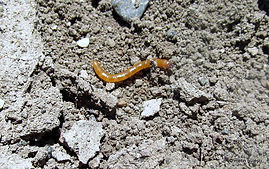TÜTÜNDE TELKURTLARI*
Agriotes spp.
Telkurtları (Agriotes spp.)'nda türlere göre renkler değişmekle birlikte erginlerin renkleri genel olarak gri ile siyah arasındadır. Vücutları uzun ve yassı olup vücut arkaya doğru incelir. Üst kanatları (elitra) uzunluğuna çizgili ve noktalıdır. Boyları genellikle 8-10 cm dolayındadır. Ters çevrildiklerinde veya sıçramaları sırasında "çıt" diye ses çıkarırlar.
Larvalar mum sarısı rengindedir. İnce uzun ve silindir biçiminde olan vücutları sert yapılıdır. Halkalar belirgindir. Dokunulduğunda sert hareketlerle kıvrılırlar.



Telkurtları kışı larva ve ergin olarak geçirirler. Larvalar kışı toprak derinliklerinde, ergin ise çoğunlukla toprak içinde oluşturduğu hücre içinde, ot yığınları altında veya gizlenmelerine elverişli yerlerde geçirir. İlkbaharda larvalar toprak yüzeyine yaklaşarak beslenir. Erginler de bulundukları yerden ayrılarak beslenmeye ve çiftleşmeye başlar. Çiftleşen dişiler yumurtalarını temmuz ortalarına kadar toprağın 10-15 cm derinliğine tek tek veya 30-40 adetlik kümeler halinde koyarlar. Bir dişi 150 kadar yumurta bırakır. Yumurtaların açılması 30-40 gün sürer. Çıkan larvalar hemen beslenmeye başlar. Fakat ilk dönemlerde özellikle kuraklığa çok duyarlı olmaları nedeniyle çok sayıda ölüm meydana gelir. Larvalar gelişmesini ortalama 3-4 yılda tamamlar. Olgun larvalar yazın toprağın 30-40 cm derinliğine inerek bir kokon içinde pupa olurlar. Yazın meydana gelen erginler ertesi ilkbahara kadar toprakta kalırlar. 3-5 yılda bir döl verirler.



Erginler tütün yapraklarında beslenirse de zararları önemli değildir. Larvalar bitkilerin toprakaltı organlarında beslenir, ince kökleri koparır, kökleri zarar gören bitkiler kolayca kurur. Olgun larvalar daha ağır zarara yol açar.
Zararlı Ege, Marmara ve Karadeniz Bölgesi ile Güneydoğu Anadolu Bölgesi tütün alanlarında bulunmaktadır.
Telkurtları polifagtır. En çok zarar yaptığı bitkiler arasında tütün, mısır, buğday, arpa, yulaf, şeker pancarı, pamuk, soğan ve patates yer almaktadır.
Telkurdunun tütün bitkisinde tespit edilen doğal düşmanı bulunmamaktadır.
-Larvalar dayanıklı görünmesine rağmen çevre koşullarına çok duyarlıdır. Soğuk ve kurak koşullar popülâsyonu azaltır.
-Telkurdunun yüzeye yakın olduğu yaz sonları veya sonbaharda yapılan toprak işlemesi büyük ölçüde ölüme neden olur.
-Genç larvaları kuraklığa karşı iyi biçimde koruyan tarla içindeki veya çevresindeki devamlı veya geçici çayırların sürümü yazın yapılmalıdır.
-Toprağı tam doyuran sulama tel kurtlarını öldürme bakımından çok etkilidir.
Yapılan sürveylerde metrekarede 6-15 adet larva olduğunda mücadele yapılır.
İlaçlamada, sırt pülverizatörü (mekanik, otomatik, motorlu) ve süzgeci i kova kullanılır.
İlaçlı su iyice karıştırılarak toprak yüzüne pulverize edilir. Toprak 15-20 cm derinliğe kadar karıştırılır. Tütün fideliklerinde bitki koruma ürünleri süzgeçli kova yardımı ile de atılır.
*Tarım Bakanlığı Zirai Mücadele Teknik Talimatları Cilt:2